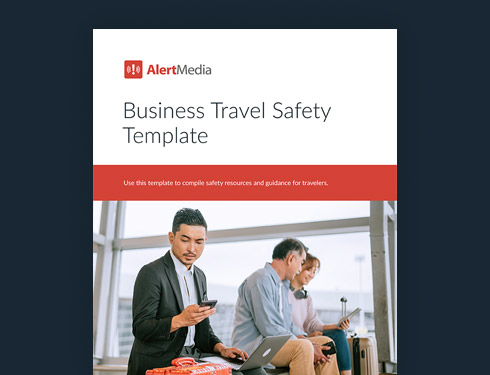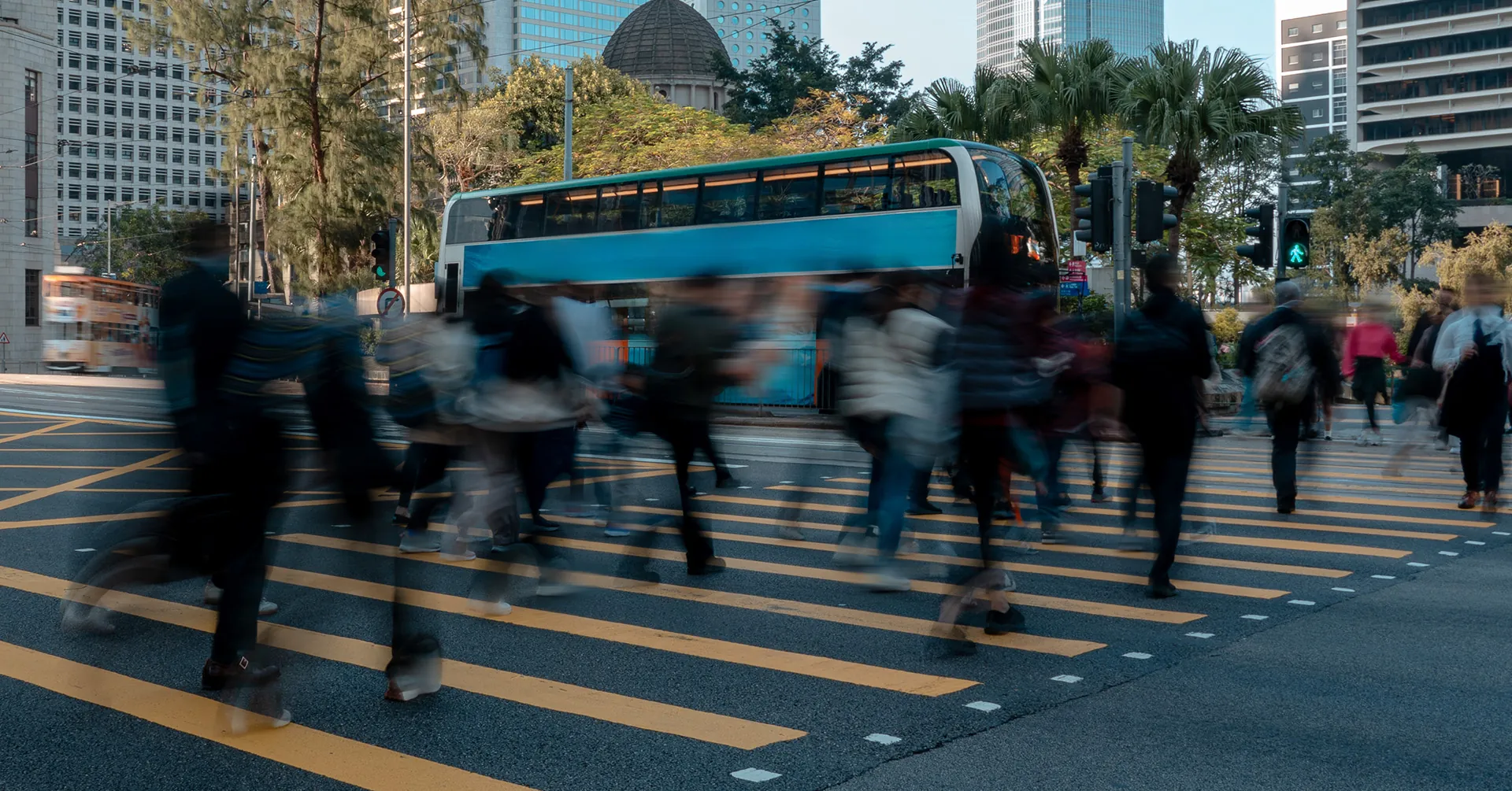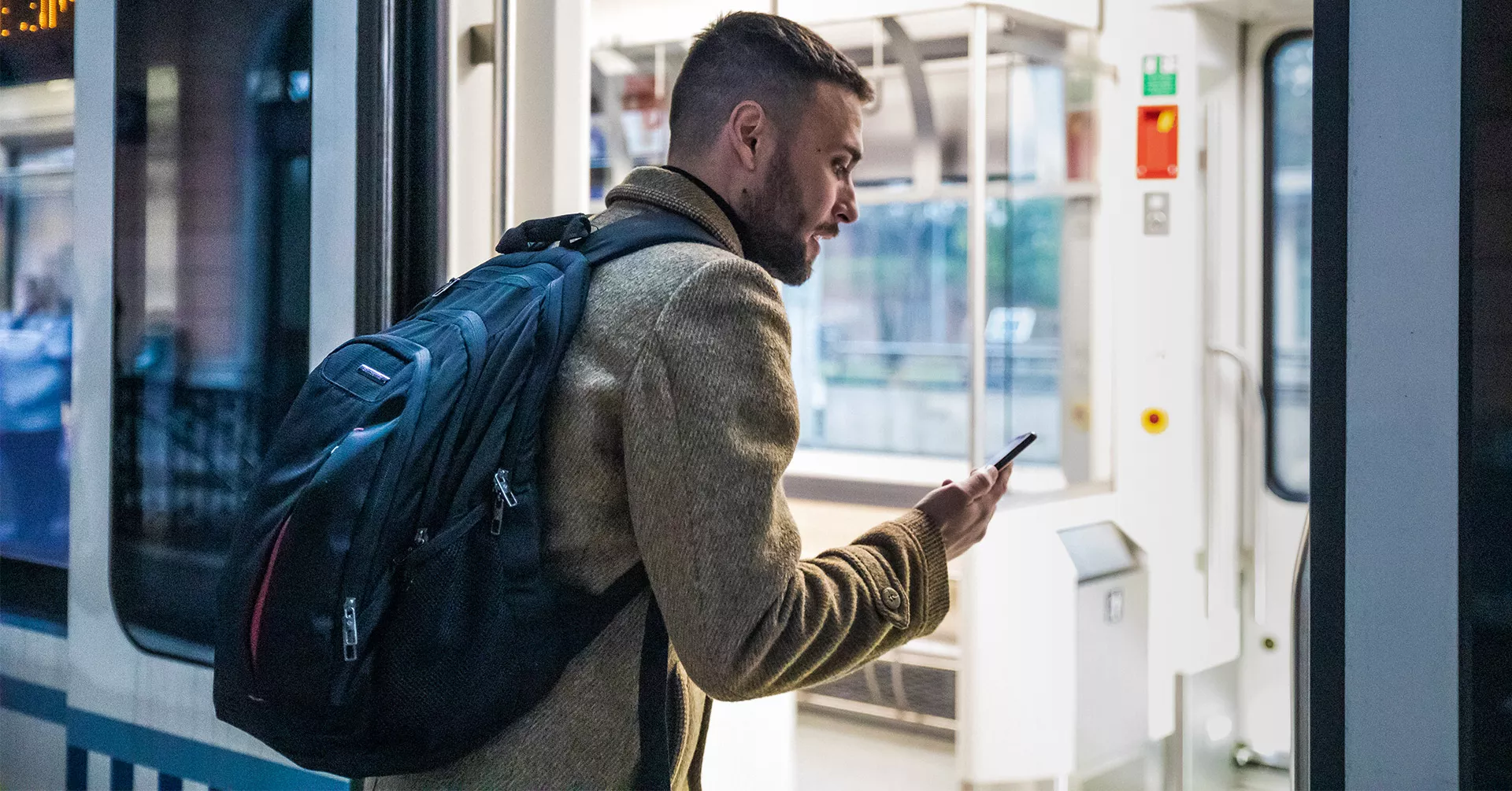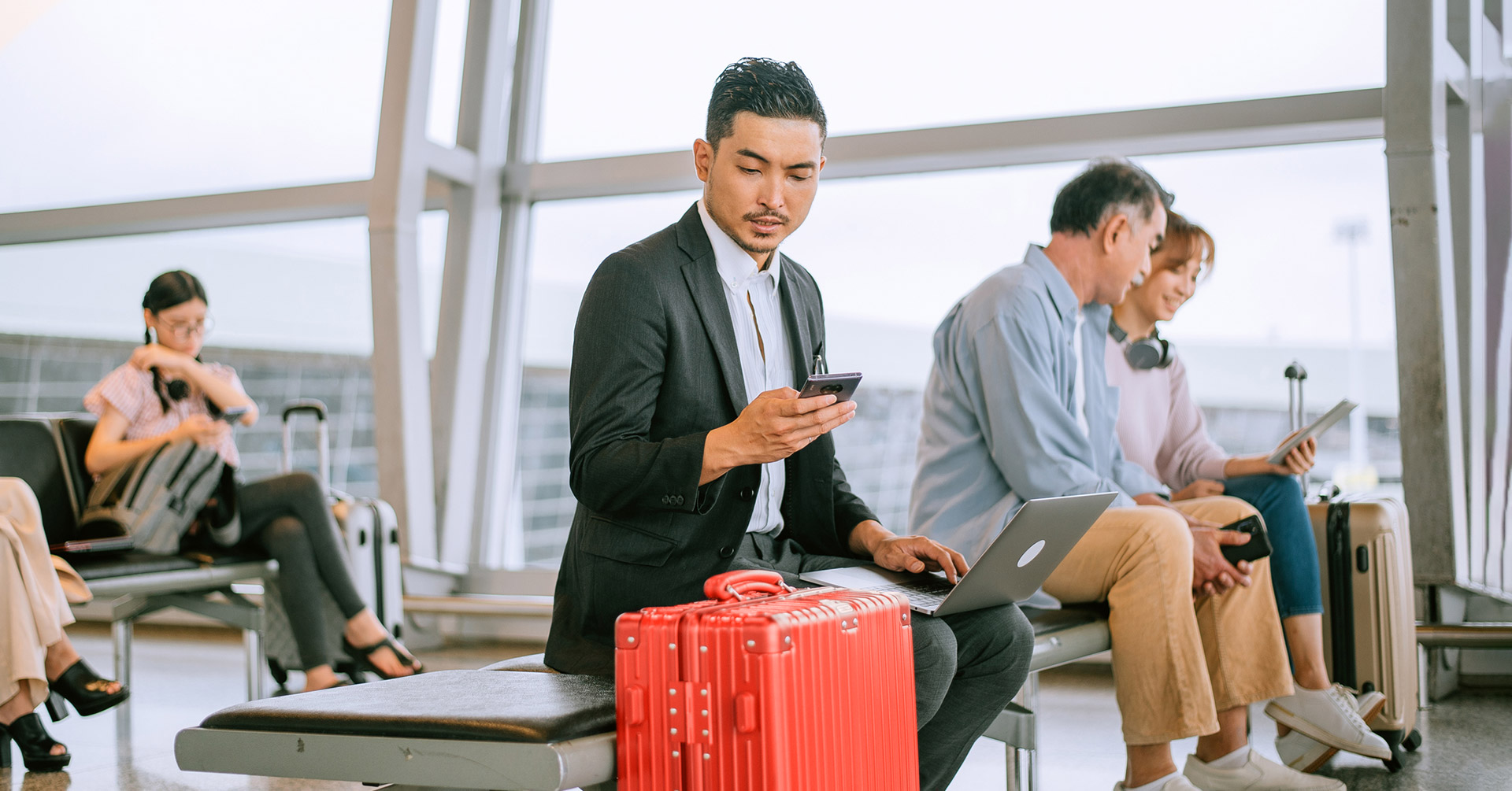
20 Business Travel Safety Tips and Guidelines for Employees
Traveling for business introduces a host of problems. These business travel security tips will help you avoid them.

Business travel is a large part of many corporate jobs today—but how should businesses go about protecting their employees when emergencies happen away from the home office? Worryingly, the Global Business Travel Association found that 46% of those who travel for work don’t have a corporate travel safety plan.
Safety culture might begin in the office, but it must also include employees who travel domestically and internationally. Would you want to be one of the 22% of business travelers who haven’t been told who to contact if they have an emergency abroad? Accidents, illnesses, pickpocketing, and getting caught in extreme weather events can happen on any business trip. Committing to employee well-being should include travel safety guidelines for employees that help them stay safe while performing their job, wherever in the world it may take them.
In this article, we’ll explore why every company needs a corporate travel safety plan and share 20 essential business travel safety tips that will help keep employees safe while traveling.
Download Our Business Travel Safety Template
Benefits of a Business Travel Safety Plan
As business travel slowly returns to pre-pandemic levels, companies have a duty of care to provide their employees with the necessary tools and resources for a safe and successful trip. Whether you’re integrating business travel security into an existing safety policy or creating a separate document, preparing for secure travel comes with many benefits.
Enhancing safety

Business travelers are exposed to a huge variety of risks. These risks can be related to civil unrest, weather events, or terrorist incidents, to name a few possibilities. A corporate travel safety plan can give your employees the information they need if they’re affected by one of these alerts.
Increasing employee trust and retention
Many employees enjoy traveling for business, with 85% of those traveling for work saying they look for this benefit when considering new job opportunities. Business travel can help boost professional development, provide job fulfillment, and help employees perform better. But only when it’s done right. A negative experience due to a poorly planned or unsafe trip can impact an employee’s opinion of their role.
Saving time and money
Business travel can lead to higher profits and revenue, but only if done safely and properly. Employees who aren’t adequately prepared to travel safely are more likely to encounter complications that cost the company significant additional resources, monetary and otherwise.
Even the largest multinational corporations can improve how they prepare for the hazards of business travel. International SOS recently supported a business traveler who had to undergo hospitalization for additional COVID-19 tests when traveling to Vietnam for business. Complicating matters, the employee was unsure how to obtain discharge paperwork and what to do while waiting for approval to catch his return flight. Not only do situations like this one incur business costs, but they can also significantly impact the individuals involved.
Building a culture of safety
Showing your employees that you’re invested in keeping them free from danger from the moment they leave home to the moment they return builds a culture of safety in your business. With safety ingrained in your company culture, employees know they are empowered to practice safety, which means they are more likely to make safer choices when working away from the office.
Additionally, you are empowered to make safe choices for your staff. You can fully consider the safest way to incorporate business travel and know your employees will trust your decision. Additionally, you can ask for their input when developing your business travel safety plan to show you’re committed to your safety culture.
20 Business Travel Safety Tips
Now that we’ve covered the rationale and benefits of developing a work travel safety and security policy, it’s time to consider what you’ll need to include in your safety plan. Our business travel safety tips are designed to help you take action with confidence to protect your employees.
1. Develop a corporate travel safety policy
It’s always better to be proactive rather than reactive—and a business travel safety and security policy is one of the best ways to fulfill your duty of care to employees while they’re traveling. This document should include all training, procedures, and resources required for your business to keep employees safe.
2. Prioritize health and safety
Predictable and unpredictable risks emerge in the global threat landscape, and travelers are particularly vulnerable. Your corporate travel safety policy should place employees’ health and safety front and center, with business priorities taking a back seat. It is your duty to care for employees no matter where they may be working, and traveling employees adopt a higher level of risk, which calls for an equal expansion of support and protection. Only when your people are safe and secure can they fulfill their responsibilities to the business.
3. Secure buy-in
Consult key stakeholders, particularly those responsible for travel risk management, about your plans for business travel. They can help support your team members while they’re abroad or bolster your safety planning with their perspective and expertise.
4. Delegate responsibilities
As with any policy creation, assigning specific roles is best to ensure accountability and thoroughness. Travel safety can be a big undertaking depending on the destination and nature of the trip, so having a team to back you up will make complicated operations run more smoothly. Your plan should specify who is responsible for which tasks to ensure everything is taken care of.
5. Conduct a risk assessment
Business travelers face a wide range of threats and impediments, including but not limited to
- Travel disruptions
- Crime and terrorism
- Political or social unrest
- New travel laws
- Disease outbreaks and health emergencies
- Extreme weather
- Natural disasters
Companies need to actively monitor an employee’s travel destination before a business trip to understand whether there are any active or potential threats in that area. A formal threat assessment calls on stakeholders to analyze potential travel risks and determine whether preventive measures are necessary—or whether to avoid specific high-risk travel plans altogether. Travel safety maps are another helpful way to visualize the threats affecting different locations, and utilizing a threat intelligence system with threat history can give you an idea of previous incidents in an area.
6. Ready your team for anything
The all-hazards approach can be a valuable framework when designing standard employee travel practices. While you don’t need to catalog every potential detail and create a corresponding solution (although you should do so for likely or high-impact events), you can cultivate the capacity, resources, and security measures to react to anything at any time.
ISO 31030 provides a comprehensive standard for managing travel risk through end-to-end guidance on best practices for protecting people and ensuring business continuity.
7. Create an essential travel safety checklist
Corporate travel safety policies will likely vary from company to company and trip to trip, but there are a few things to consider every time an employee travels:
- Pre-trip planning
- What to pack (safety-related)
- Travel documents
- Health safety
- How to find emergency services or healthcare
- Ground transportation safety (e.g., car rental or public transport guidelines)
- Communication protocols
8. Maintain a living travel policy document
Once you create your corporate travel security policy, review and update it regularly—at least once per year. Communicate any changes to your employees and offer training refreshers. Without the most up-to-date plans, your employees may be ill-equipped to make the best safety choices before and during their trips.
9. Provide safety training for traveling employees
Safety training can help employees gain situational intelligence and know how to react to threats, from natural disasters to political instability or terrorism. If something goes wrong, you won’t be there in person to help support your people. By training your team ahead of time and offering essential safe-travel advice, they will be ready to react to common threats and stay as safe as possible. In particular, situational awareness training can help people stay sharp even in unfamiliar environments and situations.
10. Research and respect local customs
Many travelers remark on “culture shock” when immersed in a new place. Sometimes, visitors can transgress cultural boundaries without even knowing it. Provide education on local laws and customs to help prepare your people and reduce any social friction they might encounter on their trip.
Accommodation and hotel security
When booking accommodations for business travel, there is more than proximity and price to consider—safety is paramount. Hotels can present unique security challenges, from cyber risks to physical threats. Here are a few tips you can pass on to your employees on safeguarding themselves during their stay.
Perform a hotel safety check: Before booking, research the area using resources like local government travel advisories or corporate travel platforms such as CWT Safety and Security. Opt for accommodations with visible hotel security measures like surveillance systems, 24-hour staffed front desks, and secure access to guest-only areas.
Secure your room and belongings: Once checked in, ensure your hotel room’s locks function properly. Use secondary security tools like a portable door-stop alarm or door wedge for added protection. Keep essential documents—passports, visas, and backup payment methods—either on your person or locked in the hotel safe when not needed.
Stay cyber aware: Hotel Wi-Fi networks are common targets for cybercriminals. Avoid accessing sensitive company data or logging into work accounts using public Wi-Fi without a VPN. Better yet, use a mobile hotspot whenever possible.
Know the emergency evacuation plan: Familiarize yourself with your hotel’s emergency exits and fire evacuation procedures. In the event of a fire, severe weather, or human trafficking-related threat, situational awareness can make all the difference.
Be vigilant about visitors: Always verify visitors before opening your door, even if they claim to be hotel staff. Use peepholes or call the front desk to confirm unexpected service requests. If something feels off, trust your instincts and alert hotel security immediately.
Monitor local threats: Subscribe to weather warnings and local safety alerts via your employer’s emergency communication system. Hotels may not proactively inform guests of nearby incidents, so staying informed is your responsibility.
11. Train to avoid violent incidents
Many business trips are perfectly peaceful, but violence is a potential threat that calls for planning, employee training, and threat monitoring of all locations your employees may visit. In 2017, 53% of business travelers were impacted by terrorism. While these risks may be difficult to imagine, it’s important to feel entirely confident in your preparedness efforts around potential violent incidents. Practicing drills with crisis simulation exercises can help your employees know how to react and stay aware of the risks if they find themselves in a dangerous situation.
12. Be mindful of individuals’ varying risks
Remember which of your employees might be at greater risk while traveling. For example, 83% of female business travelers have safety concerns. Any business travel safety training should also include specific guidance and resources to address or report issues that may predominantly affect marginalized groups, like assault, hate crimes, kidnapping, or sexual harassment. It is essential to keep a record of travelers’ itineraries in these cases to help them as soon as possible if anything goes wrong.
13. Educate travelers on insurance coverage
If your company has a business travel insurance policy, ensure employees understand what it covers and how to use it in an emergency. For example, many policies cover expenses related to medical emergencies, trip cancellations or interruptions, medical evacuations, and lost valuables. If your traveling team members don’t know about that support, they might not use it and put themselves or their work at risk.
14. Establish a reporting process
Providing employees with a method for reporting issues will lead to a better overall travel experience. Despite your best efforts, the world of travel is chaotic, and your plans may fall through. Stay in communication with agents managing travel plans to learn of canceled flights, double-booked accommodations, and other snags as soon as possible so you and your team can remedy them and keep your traveling workforce on track.
15. Observe repeat travel spots between visits
Even after your employees return from a travel location, it’s a good idea to continue monitoring the area. This will give you a firmer idea of the local threat landscape and the frequency and severity of common risks. Regional monitoring is critical if your employees travel to this area frequently, such as to visit a partner’s or client’s office.
16. Invest in quality communication software
The right tools can go a long way to ensuring your employees stay safe, and this is especially true of communication for business travel. Your emergency communication tool should include a combination of the following capabilities and characteristics:
- Intuitive interface: Send and receive alerts with ease
- Two-way messaging: Allow users to reply with status updates
- Multichannel notifications: Use different channels such as text message, phone call, email, or WhatsApp, to communicate
- Wellness checks: Quickly survey employees to see if they’re safe or need assistance
- Reduced delivery time: Use pre-built notification templates for different scenarios when seconds count
- Centralized information: Create event pages to provide one source for all updated information related to a specific event
- Availability: Access via mobile devices, as incidents can occur at any time
17. Maintain an up-to-date database of employee contact information
No matter how robust your communication technology and processes are, if you don’t have the correct info, your thoughtful notifications won’t reach the people who need them. Standard solutions include self-service information updating in HRIS systems or company directories. You need a communication system that syncs contact info with those existing records so you don’t have to worry about an employee missing important information because their phone number is out of date.
18. Deploy threat intelligence and monitoring tools
Leading up to and during an employee’s business trip, the more you know about potential threats, the better you’ll be able to ensure their safety and security. A threat intelligence system is critical for keeping track of threats where your employees are traveling, as well as at home. Reliable threat monitoring tools can help you protect your employees during their trip by tapping into thousands of data sources to intelligently track and monitor threats in real time. These tools also take into account threat history to help you form a clearer picture of what’s happening where.
19. Engage with intelligence analysts
Keeping track of every emerging threat can be an enormous task, especially for small in-house teams. Luckily, high-quality threat intelligence services include live professional analysts who help you sift through the firehose of information and isolate only the most relevant. Some solutions, such as AlertMedia’s, even allow you to chat directly with an analyst to fine-tune your awareness.
20. Increase visibility with location data
If your employees deviate from the plan, willingly or not, you’ll be aware only if they take the time to notify you. You eliminate the guesswork by equipping employees with location-tracking technology or apps like GPS-enabled employee communication software. This form of tracking should be voluntary to avoid unnecessary surveillance. Still, employees might feel more comfortable in certain situations if they know their location is shared with those responsible for their safety and security.
Example employee business travel safety checklist
Employees should take a proactive approach to risk mitigation to maintain safety and productivity while traveling for work. Here is an example of a checklist you can send to employees for use before and during each trip to stay protected and connected while supporting broader organizational travel risk management efforts:
Before travel
- Enroll in your organization’s travel risk management or duty of care program
- Share your full itinerary and accommodation details with your manager and designated emergency contact
- Confirm emergency contacts are updated in your employer’s mass notification system
- Pack essential documents, backup identification, and an emergency contact card
- Secure any medications in clearly labeled containers
- Load key apps for navigation, translation, and emergency alerts
- Review health and safety protocols for your destination
During travel
- Use a VPN when accessing company systems via public Wi-Fi
- Keep devices and bags within sight at all times
- Avoid high-risk areas and travel alone after dark only when necessary
- Use licensed transportation services exclusively
- Carry a copy of your hotel’s emergency evacuation plan
- Regularly check in with your supervisor or designated contact
- Monitor real-time threat alerts from your employer or official sources
Preparation Is the Key to Business Travel Safety and Security
A detailed corporate travel security plan is necessary in today’s threat landscape. With business travelers exposed to a wide variety of risks, companies need to create a culture of safety that extends to employees’ diverse destinations so they can stay safe and perform at their best.
Your travel safety guidelines for employees should not be a static document. Consistently reassess relevant threats and update the plan to account for changes to your travel program or policies. It’s vital to account for all hazards and ensure your employees have the latest information about how to respond. Use the tips and tools we’ve covered to help keep your business running—and give your employees peace of mind.




